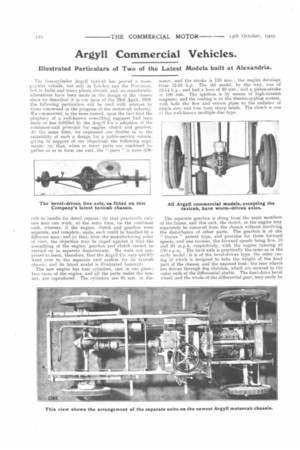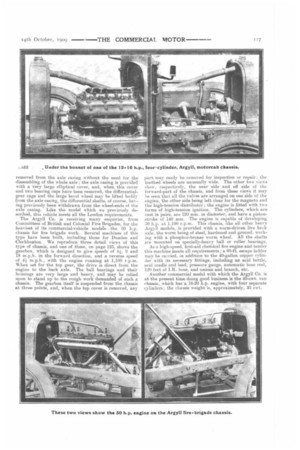Argyll Commercial Vehicles.
Page 6

Page 7

If you've noticed an error in this article please click here to report it so we can fix it.
Illustrated Particulars of Two of the Latest Models built at Alexandria.
The four-cylinder Argyll taxicab has proved :I mostpopular vehicle, not only in London and the Provinces. but in India and many places abroad, and, as considerable alterations have been made in the design of the chassis since we described it in our issue of the 23rd April, 1008, the following particulars will be read with interest by those concerned in the progress of the motorcab industry. We commented, in the issue named, upon the fact that the prophecy of a well-known consulting engineer had been more or less fulfilled by the Argyll Co.'s adoption of the combined-unit principle for engine, clutch and gearbox. At the• same time, we expressed our doubts as to the suitability of such a design for a public-service vehicle, giving in support of our objections the following arguments: (a) that, when so many parts are combined together so as to form one unit. the " piece " is more difti cult to handle for detail repairs; (b) that practically only one man can work, at the same time, on the combined unit, whereas, if the engine, clutch and gearbox were separate, and complete, units, each could be handled by a, different man; and (c) that, from the manufacturing pointof view, the objection may be urged against it that. the assembling of the engine, gearbox and clutch cannot be carried on in separate departments. We were not surprised to learn, therefore, that the Argyll Co. very quickly went over to the separate unit system for its taxicab chassis, and its latest model is illustrated herewith.
The new engine has four cylinders, cast in one piece ; two views of the engine, and all the parts under the bonnet, are reproduced. The Cylinders are 84 mm. in dia meter. and the stroke is 110 mm.; the engine develops from 12-16 h.p. The old model, by the way, was of 12-14 h.p., and had a bore of 80 mm.„ and a piston-stroke of 1.00 inm. The ignition is by means of high-tension magneto, and the cooling is on the th.ermo-syphhn system, with both the flow and return pipes to the radiator of ample size, and free from sharp bends. The clutch is one of the well-known multiple-disc type.
The separate gearbox is slung from the main members of the frame, and this unit, the clutch, or the engine may separately be removed from the chassis without involving the disturbance of other parts. The gearbox is of the " Govan " patent type, and provides for three forward speeds, and one reverse, the forward speeds being five, 10 and 20 m.p.h. respectively, with the engine running at ;?50 r.p.m. The back axle is practically the same as in the early model: it is of the bevel-driven type, the outer casing of which is designed to take the weight of the hind part of thechassis, and the imposed load; the rear wheels. are driven through dog clutches, which are secured to theouter ends of the differential shafts. The final-drive bevel wheel, and the whole of the differential gear, may easily he removed from the axle casing without the need for the dissembling of the whole axle; the axle casing is provided with a very large elliptical cover, and, when this cover and two bearing caps have been, removed, the differentialgear cage and the largo bevel wheel may be lifted bodily from the axle casing, the differential shafts, of course, having previously been withdrawn from the wheel-ends of the axle casing. Like the model which we previously described, this vehicle meets all the London requirements. The Argyll Co. is receiving many enquiries, from Committees of British and Colonial Fire Brigades, for the heaviest of its commercial-vehicle models— the 50 h.p. chassis for fire brigade work. Several machines of this type have been built, including those for Dundee and Cleckheaton. We reproduce three detail views of this type of chassis, and one of these, on page 125, shows the gearbox, which is designed to give speeds of 4, 9 and 18 m.p.h. in the forward direction, and a reverse speed of 4, m.p.h., with the engine running at 1,100 r.p.m. When set for the top gear, the drive is direct from the engine to the back axle. The ball bearings and their housings are very large and heavy, and may be relied upon to stand up to the rough work demanded of such a chassis. The gearbox itself is suspended from the chassis at three points, and, when the top cover is removed, any
part may easily be removed for inspection or repair ; the toothed wheels are unusually wide. The other two views .how, respectively, the near side and off side of the forward-part of the chassis, and from these views it may be seen that all the valves are arranged on, one side of the engine, the other side being left clear for the magneto and the high-tension distributor ; the engine is fitted with two forms of high-tension ignition. The cylinders, which are cast in pairs, are 120 mm. in diameter, and have a pistonstroke of 140 mm. The engine is capable of developing 30 h.p. at 1,100 r.p.m. This chassis, like all other heavy Argyll models, is provided with a worm-driven live back axle, the worm being of steel, hardened and ground, working with a phosphor-bronze worm wheel. All the shafts are mounted on specially-heavy ball or roller bearings.
As a high-speed, first-aid chemical fire engine and tender this machine meets all requirements ; a 60-ft. escape ladder may be carried, in addition to the 40-gallon copper cylinder with its necessary fittings, including an acid bottle, acid cradle and lead, pressure gauge, automatic hose reel, 120 feet of 1.11. hose, and unions and branch, etc.
Another commercial model with which the Argyll Co. is at the present time doing good business is the 40-cwt. van chassis, which has a 16-20 h.p. engine, with four separate cylinders; the chassis weight is, approximately, 35 cwt.




















